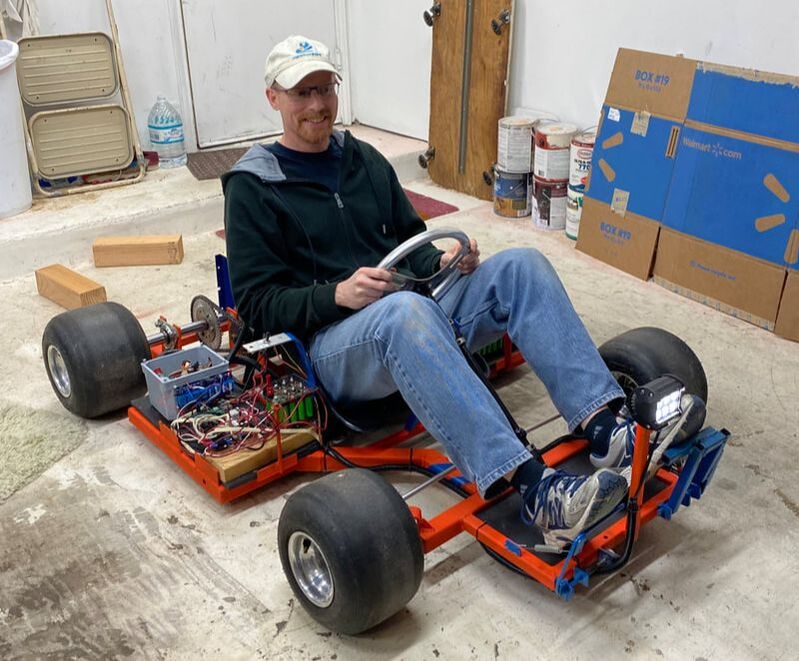|
Hey Electrified Miata team, here's the latest update in the never ending quest to go faster, have fun, and be safe! For those of you following along, last week, the plans were to produce documentation, mounting parts to the kart, re-routing wires so they didn't drag the ground, and producing a plan for cell testing, and of course, having fun. The problem we were facing last week of the relay's dropping out under higher power demands needed to be solved as I wanted this weeks meeting to be able drive the kart around, that is to have fun! However, not everything happens like I want the first time. The relay dropping was quite a mystery and the only clue I had was that the voltage on the Pi looked like it went down as the relays were activated. As the voltage, supposed to be 5 volts, got down to 4.8 volts, it appeared that the DC-DC converter that powers the Pi couldn't keep up. I looked on Amazon and saw some adjustable DC-DC converters and a solution looked to be only one click away. I also searched the internet for different ways of hooking the relay panel up. I found one where the relay board was connected to the power supply first and only used the Pi's 3.3 volt supply as a reference. A few days later, the parts arrived, I wired them up, checked the voltage, and the problem didn't happen anymore. I didn't try and drive the Kart around as I wanted to share the first drive experience with all the guys who worked on it. I went to work on the software, so the Pi would start automatically and I wouldn't need a monitor and keyboard, which are decidedly inconvenient when driving the Kart. Modifying the software didn't take very long but I realized that once the Kart software was started, I had no easy way to shut the system down with out adding another switch. I really like to keep hardware to a minimum if there is any other way. Teresa thought of an in-activity timer and I thought possibly blue tooth would work great for a simple shutdown command. I had visions of the Kart altering the driving profile based on the Bluetooth Id in the driver's seat, so I started investigating how that might work. After a full day of attempting to get the simplest thing to work, I got the Pi to see my IPhone and what services the IPhone offered, but that was a far as I could get. Getting Bluetooth to work will take more time and is seemed complex. Teresa was right again, lol. Anyone out there know how to pair a Pi and iPhone without a special Bluetooth dongle? I shelved the Bluetooth effort and looked at using WiFi, but ran out of time before our meeting. At the meeting, we started re-routing the wires and anchoring everything . Brian brought four touch screen devices to see how they would fit in the steering wheel which is our preferred mounting location right now. We selected one and he'll bring it back ready to run. Within half an hour, we were ready to take it for its first test drive! Bruce drove a little ways and then the relay dropped out again! I had fixed everything *but* the real problem. The relay dropping out would restart in about 10 seconds so nearly everyone got to try the kart. Then the plug to the mini-pack which powered the Pi popped off which rebooted the Pi and it wouldn't start again. That happened at the far end of the cul-de-sac and Bruce gave me an assist back to the garage were we spent time investigating the relay drop out problem. Bruce's assist was nearly as powerful as the Kart right now, since we have the performance dialed way back to save the battery. The good news is the battery appears to be holding up quite well with little voltage sag and showing plenty of charge left, despite nearly all of us making a few laps around the cul-de-sac. Electric car nuts at play! Bruce, Brian and Ed were troubleshooting the relay problem while Joe drew me the opto-isolation circuit needed so I could hook up a Pi's serial port to our BMS system, when it arrives. Thru the WiFi, we were able to determine that the Pi was seeing the enable switch activated for a brief second. Bruce, Brian and Ed isolated the problem the power being supplied to switch through a resistor. After re-tightening that connection , the problem still existed, but was much less frequent. It looks like we finally tracked down the real problem. I'll take care of that before we meet again.
We are not meeting next week, but will meet the week after that. I'll solder and test that switch connection and start on cell testing, so we'll know if we can set the performance up a little bit, even with one battery. Cell testing will also tell us what to expect if we are draining the batteries too rapidly, past their stated limits. As always, thanks for reading!
0 Comments
Leave a Reply. |
AuthorBill likes cars that understand the 'go fast now' pedal. Archives
May 2022
Categories |
Proudly powered by Weebly


 RSS Feed
RSS Feed